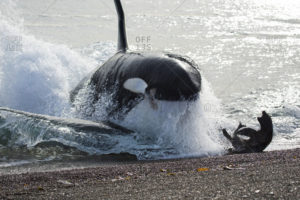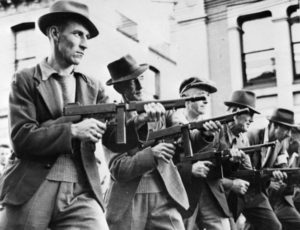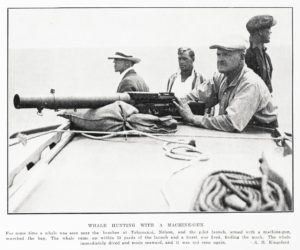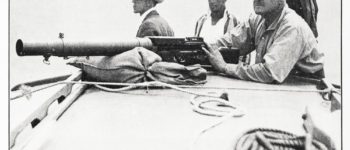1934: Whale Hunting With A Machine Gun
January 17, 2021
By AHNZ
On 6th January 1934 an apex predator, a killer whale, started patrolling Nelson’s Tahuna Beach looking for something (or someone) to eat. Being that this was New Zealand in the 1930s, Nelsonians took to the waves and machined gunned the orca dead. Threat eliminated.
 How much of a threat the orca posed in the first place is uncertain. We know from TV wildlife documentaries that killer whales are cruel and deadly predators that love to torture and eat seals. Plenty of humans have been killed or maimed by these animals in captivity but not in the wild. Yet, it is with captivity that attitudes have changed and the animal is no longer seen as a threat to be eliminated. In the last few decades, if we see an orca about any of our bays we’re delighted and it makes the newspapers. Unlike Opo (1955) or Pylorus Jack (1888) the killer whale was considered¹ a sharp-toothed man-eater that made killing fields of our recreational beaches. It had to go.
How much of a threat the orca posed in the first place is uncertain. We know from TV wildlife documentaries that killer whales are cruel and deadly predators that love to torture and eat seals. Plenty of humans have been killed or maimed by these animals in captivity but not in the wild. Yet, it is with captivity that attitudes have changed and the animal is no longer seen as a threat to be eliminated. In the last few decades, if we see an orca about any of our bays we’re delighted and it makes the newspapers. Unlike Opo (1955) or Pylorus Jack (1888) the killer whale was considered¹ a sharp-toothed man-eater that made killing fields of our recreational beaches. It had to go.
“Whale hunting with a machine gun is unusual. On Saturday morning the Nelson pilot launch, armed with a machine gun and manned by several willing hands, set off in search of a whale that has been haunting the bathing beaches at Tahunanui for some time past. After cruising for an hour without success the monster was seen coming towards the launch, and then 15 yards from the bow came to the surface to blow.,The gun was immediately in action, and several shots found their mark. The whale dived at once and was not seen again.”- Whale Hunting, Otago Daily Times
“A few weeks ago a killer whale took up patrol work in front of the Tahuna bathing sheds, causing consternation among bathers. It was ultimately frightened away by machine-gun fire after having scorned the efforts of riflemen for a week or so. The whale was seen by a local yachtsman in the bay yesterday in a very low condition. It was probed by oars, and hardly moved. It appeared to have been ripped by bullets near the tail.” – Killer Whale at Nelson, Press
Initially, the orca was wished a “Happy new year” for 1934 with some warning shots from rifles. Being a slow learner, other methods would need to be employed. So, a crew of 5, including photographer Reg Kingsford, set out on the pilot launch to wrap things up for the sharp-toothed monster. The men had what appears from the photo (top) to be a WW1-era Lewis automatic machine gun mounted over a sack of sand on the bow of the launch.
The whale took some heavy heat, especially in the tail end, and dived seaward to escape. After a painful 4 weeks in misery the orca finally died, next being seen unresponsive and near death and still in Tasman Bay.
 A reason why this killer whale encounter was handled differently in 1934 as it would be in the 2020s comes down to Moral Culture. The people of the mid-1930s were in a Physical Culture phase which ultimately led into a the Honour Culture of WW2. These Nelsonians were practical men, ready to personally defend their territory from threats without asking for government protection or permission. New Zealand’s mainstream today resembles the Slave Culture early 1930s era that preceded this whale hunt. Likewise, our outlook can be expected to click over to a strong Honour Culture in the 2020s that these hunters would recognise as similar to their own.
A reason why this killer whale encounter was handled differently in 1934 as it would be in the 2020s comes down to Moral Culture. The people of the mid-1930s were in a Physical Culture phase which ultimately led into a the Honour Culture of WW2. These Nelsonians were practical men, ready to personally defend their territory from threats without asking for government protection or permission. New Zealand’s mainstream today resembles the Slave Culture early 1930s era that preceded this whale hunt. Likewise, our outlook can be expected to click over to a strong Honour Culture in the 2020s that these hunters would recognise as similar to their own.
—
1 Exception, in Australia, of Old Tom who worked in a symbiotic relationship with the whalers of Eden. Ref. Wiki
Ref. Otago Daily Times (11/1/1934); Papers Past
Ref. Press (12/2/19340; Papers Past
Image ref. A. R. Kingsford, Auckland Weekly News (17/1/1934); Auckland Libraries Heritage Collections
Image ref. Wartime defenders of Christchurch a little later in the same era as the Whale Hunt; Christchurch Star, 15 Jan 1942; DA-03316, NZ National Archives; 1940s: Defend New Zealand: Christchurch vs Auckland, AHNZ
Update Feb/2021: Added in the 1915 story of the ‘blackfish’
Image ref. 4 February 1915: Oil from the sea: A mother orca, 19ft long, and calf, caught in the harbour at Tauranga.; Sir George Grey Special Collections
 Like Comment Share
Like Comment Share






